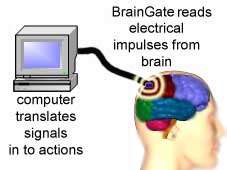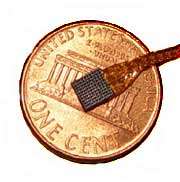November 1, 2005 feature
Look ma, no hands!

A few years ago scientists managed to wire a monkey’s brain to a robotic arm. The monkey learned to manipulate the arm simply by thinking. This year, John Donoghue at Brown University has managed to do the same – with a human.
Matthew Nagel, a C4 paralytic – from the neck down – has been playing pong, drawing circles and manipulating a computer with thoughts alone via the BrainGate. This technology promises to have profound changes on the lives of millions of paralyzed and handicapped individuals, but implications run much deeper and may one day affect us all.
Imagine being able to control your environment simply by thinking – forget the remote control. It’s utopia for the die hard couch potato – everything’s just a thought away.
Tens years ago, this technology was thought by many scientists to be impossible because of the complexity of the human brain. At 3lbs. it packs in an incredible 100 million neurons making it the most compact supercomputer on the planet. Thoughts are created by electrical impulses that when amplified, sound a lot like static. From this static arose literary masterpieces like War and Peace and culturally dubious drivel like Bevis and Butthead.
Using MRI technology, scientists began to map brain activity. Unfortunately, it looked as if millions of neurons where involved in even the simplest actions making effective mapping and recording very complex. Hundreds of tiny implants (electrodes) embedded at different locations in the brain would be needed to “read” thoughts. Unfortunately, these implants only functioned for a short period and, because of their size, endangered the surrounding neurons.
Work by Duke University’s researcher Miguel Nicolelis proved this to be wrong. He found that by sampling just a few neurons you could “read” what was going on inside the brain. Equally, he found better and more sensitive electrodes that were more tolerable as implants. These could be inserted without complications and left in place without long term damage to the cortex.

Here’s how the system works: a small chip, the 2mm x 2mm BrainGate, is surgically implanted on to the surface of the brain. Extending down into the cortex are hundred thin platinum tipped electrodes – each a millimeter long and only 90 microns at the base. These pick up the brain’s electrical signals which are then transmitted to a computer via a slender gold wires connected to each individual electrode.
After implantation, the computer system needs to “learn” what the brain-generated electrical impulses mean. Nagel preformed predetermined movements in his mind: move arm left, lift hand, rotate wrist. Each movement generated a unique signal that could be recorded. After that, he was hooked to a joystick via a computer. The computer registered his now remembered thought patterns and moved the joystick accordingly – without any physical intervention whatsoever.
This learning process can be slow and frustrating, but Nagel quickly learned to control the cursor and use it to perform basic tasks like opening programs and reading email. He started by thinking of making movements with a mouse, but now simply “thinks” of a cursor movement and his brain translates that desire in to electrical impulses that, via the computer, move the on screen cursor. His brain has assimilated the implant and controls it as if it’s party of the body – like a hand.
Complications from the implanted electrode appear to be few as it has already worked in monkeys for over 1000 days. However, long term problems may yet arise, according to John Donahue, the systems developer.
Other researchers have begun demonstrating less invasive methods of tapping brain waves such as external electrodes – with limited success, but Donoghue remains convinced implants will remain the best choice: “No other method gives you the power and clarity you need to transform this noisy signal into something that a patient can use."
As futurist and scientist, it’s hard not to see the explosive implications of this exciting technology. Now scientists are reading this cortex-generated electrical information, much like your first CD player read songs. Very soon they may be able to “write” information as well – just like a CD burner.
People could actually be “programmed” or fed enormous quantities of information – possibly without even engaging higher level brain activity. This would change how we communicate – think directly at your friends instead of speaking, learn – in your sleep, remember perfectly - your memories could be stored “off line” on some external device. More importantly, it will affect how we interact with our environment.
If all you need to do is think about something you want and it happens – exactly what Mr. Nagel is now doing, the only thing missing are the connections to the external world – already available with current technology.
No more searching for that pesky remote – or anything else for that matter. Everything may just be a thought away – much sooner than even the most optimistic couch potato dreamed of.
by Chuck Rahls, Copyright 2005 PhysOrg.com


















